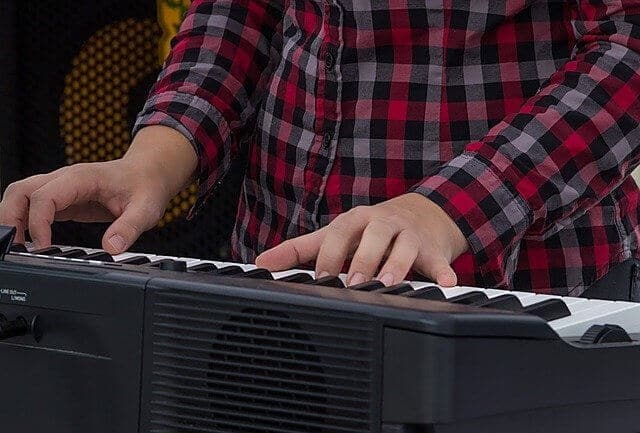*Keyboardkraze now has a nearly 24/7 chat service directly with me should you have any questions regarding keyboard/plugin choices! This is connected directly to me and it is not AI.
Table of Contents
The D Major piano scale is a scale that starts to test your finger dexterity as you will be playing two black keys in the scale. This is a fun scale to learn, and it is still relatively an easy scale to master.
This article will explain in great detail how to play the D major scale and break down the proper fingering and notes in the D scale.
If you’ve landed on this article wondering how many sharps are in the key of D, the answer is two (F#, C#). I highly recommend you check out all of the scales “how to’s” on my website as I go deep into detail and answer any questions you might have.
D Major Scale Notes
The notes of the D Major scale contain the following notes: D,E,F#,G,A,B,C#,D. As discussed above, there are two sharps in this key: F # and C#. While this scale isn’t the most difficult to play, it might present a challenge at first if your finger dexterity isn’t quite there yet.
The D Major scale follows the same simple steps that other Major keys follows: W,W,H,W,W,W,W. W refers to whole, whereas H refers to half. These refer to the notes in between each step. For example, D to E is a whole step, whereas F# to G is a half step.
You will be playing a total of five white keys and two black keys when playing this scale. I recommend beginning to play this scale with your dominant hand first to get the hang of the notes.
D Major Piano Fingering
Your left hand will start with your pinky finger, which is your five finger on your left hand. Each finger from there counts down to one and then counts upward.
You will place your left hand on D, starting with your pinky finger.
Your right hand starts with your thumb, which is your one finger, and counts upwards to five
The consistency here is that your thumb finger is always your one finger for both hands.
You will place your right hand on D, starting with your thumb.
How To Play D Major Scale With Your Right Hand
Place your one finger or thumb on D and then play the following notes, D,E,F#,G,A,B,C#,D.
The notes are as follows with the correct fingering:
D(1)
E(2)
F#(3)
G(1)
A(2)
B(3)
C#(4)
D(5)
To descend, you will do the following:
D(5)
C#(4)
B(3)
A(2)
G(1)
F#(3)
E(2)
D(1)
How To Play D Major Scale With Left Hand
Place your fiver finger(pinky) on D and play the following notes until you reach D.
D(5)
E(4)
F#(3)
G(2)
A(1)
B(3)
C#(2)
D(1)
To descend, follow these notes and fingering to reach your goal.
D(1)
C#(2)
B(3)
A(1)
G(2)
F#(3)
E(4)
D(5)
Combining Your Hands
Playing this scale with both hands will be complicated at first. I recommend taking your time and getting proficient with both hands separately before trying to master playing the D Major scale with both hands at the same time.
How To Get Better At This Scale
First things first, learn the notes of the scale like the back of your hand. Second, use a metronome and practice hands apart while learning.
Once you’re comfortable, slowly increase your tempo until you can reach 144 BPM with hands apart, and then do the same process until you can combine both of your hands.
The biggest thing I can stress as a teacher is to not move on until you feel comfortable playing the scale. If you’re barely playing the notes and finding yourself slowing down and speeding up, keep practicing until you can play accurately, then move on.
Wrapping Up
I recommend practicing the D Major scale for 10-20 minutes a day while grabbing a grasp for the key. Now that you understand the key in general, I hope you can the G Major scale.
I can’t stress the importance of learning scales early on, as this will lead to finger dexterity and good habits on your long journey.
Have fun, and don’t be afraid to leave any questions you might have while learning this scale. I have over 20 years of piano experience and would love to help.







